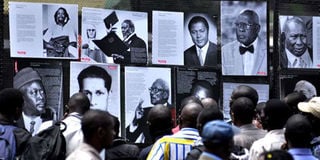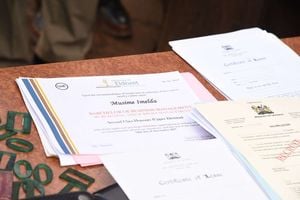How colonial jailers blocked attempts on Kenyatta’s life

Wananchi at a photo show dubbed Courage Exhibition, which was opened on October 19, 2015 ahead of Tuesday's Mashujaa Day celebrations. The exhibition is being hosted near the Kenya National Archives on Moi Avenue, Nairobi, and highlights stories of courageous individuals who paid a heavy price for Kenya. PHOTO | GERALD ANDERSON | NATION MEDIA GROUP
What you need to know:
- Records from the then Turkana district commissioner, Mr Leslie Whitehouse, reveal how the prisoners — including five of the now famous Kapenguria Six — had hatched a plot to harm Kenyatta by enlisting the services of a young Mau Mau scout, Kariuki Chotara, who had been transferred to the Lokitaung Prison.
- Jeremy Murray-Brown’s biography of Kenyatta recounts an incident in 1956 when Kenyatta received Bishop Obadiah Kariuki, one of the first indigenous African bishops of the Anglican Church, who had preached against Mau Mau.
- Interestingly, while Paul Ngei managed to remain within the Kenyatta administration, he was Mzee’s number one tormentor while they were in jail, according to records.
While serving a jail term in Kapenguria after the colonial government accused him of supporting and leading Mau Mau freedom fighters, Mzee Jomo Kenyatta once escaped an attempt on his life orchestrated by his fellow prisoners unhappy with the special treatment he was receiving.
Records from the then Turkana district commissioner, Mr Leslie Whitehouse, reveal how the prisoners — including five of the now famous Kapenguria Six — had hatched a plot to harm Kenyatta by enlisting the services of a young Mau Mau scout, Kariuki Chotara, who had been transferred to the Lokitaung Prison.
Chotara, then a minor, had been sentenced to a prison term after he was convicted of murder. He was jailed at Manyani Prison but escaped, prompting colonial authorities to send him to Lokitaung. The sentence for murder was death but in Chotara’s case, it was commuted to a jail term because he was underage.
After Kenyatta’s death, Chotara rose through the political ranks to become a powerful Nakuru District Kanu chairman and nominated MP.
In one of his notes, Whitehouse recalled the incident which happened shortly after Kenyatta had met his lawyer, Mr Dennis Pritt.
“After Pritt departed, Mzee was not only ostracised by his fellow convicts but was subjected unceasingly to vituperation and harassment of every kind. The knife attack was the climax,” the colonial administrator wrote.
Whitehouse wrote: “The inquiry which followed recorded that a recent newcomer to the prison, a young man said to be twice or thrice a convicted murderer saved from the death sentence by reason of being under 18 years of age... set upon Mzee with a knife in the prison but he was prevented by a prison warder from carrying out his intention.”
DEATH SENTENCE
The explanation, according to Mr Whitehouse, was that this was an attempt engineered by the other prisoners who knew that Chotara was too young to face a death sentence even if found guilty of killing Kenyatta.
This, however, was not the only source of friction between Kenyatta and the other prisoners.
Jeremy Murray-Brown’s biography of Kenyatta recounts an incident in 1956 when Kenyatta received Bishop Obadiah Kariuki, one of the first indigenous African bishops of the Anglican Church, who had preached against Mau Mau. According to Murray-Brown, Kenyatta, after having private discussions with the bishop, then took him to a larger room where the other prisoners were.
He writes: “(Bildad) Kaggia at once (verbally) attacked him for this (saying) there is no God (and that) Christ is only for Europeans. Kenyatta tried to quieten them. One by one, they (the Mau Mau prisoners) all trooped out of the block, leaving only Kenyatta and (General) China to receive Kariuki’s farewell prayers.”
Before his imprisonment, Kaggia had launched his own sect, Dini ya Kaggia.
While these could have been seen as minor feuds among prisoners, they would, in later years, affect Kenyatta’s relationship with his five co-accused after he ascended to the presidency. It is thus not surprising that he fell out with some of the Kapenguria Six shortly after independence.
The first casualty was Bildad Kaggia, who became the first to be dropped as an assistant minister in the first Kenyatta administration.
MYSTERIOUS DISAPPEARANCE
Kaggia continued to criticise the settlement policy of the landless and the acquisition of land by bigwigs in the government even after the fallout.
Achieng Oneko was also detained by Kenyatta in 1969, while Fred Kubai’s political fortunes nose-dived after he lost the Nakuru parliamentary seat in 1974.
Businessman Kung’u Karumba mysteriously disappeared the same year after he went to Uganda to trace his lorry.
Interestingly, while Paul Ngei managed to remain within the Kenyatta administration, he was Mzee’s number one tormentor while they were in jail, according to records.
At independence, Ngei also refused to join Kanu and formed his own Akamba Peoples Party.
In one prison hand-over report dated 1954, the local District Officer, Mr J R M Tennet said: “Kenyatta is old and mellowing. Cooking only aggravates his eczema (a skin disease). There is no hope of getting rid of the young murderer and escape artist, Kariuki Chotara. Ngei remains spokesman”.
It is now known that the British authorities had coached a key witness, Rawson Macharia, to testify against Kenyatta on the promise of a university scholarship and a job. Thus, unlike other convicts, Kenyatta was the only one jailed on the strength of a false witness. Macharia would later admit that he was indeed a fake witness and was jailed for perjury.
NGEI PROTESTS
Although on paper Kenyatta was to serve seven years with hard labour, the colonial authorities — according to records — spared him the hard labour and instead assigned him kitchen duties, to the chagrin of the other prisoners. The 1955 prison report says that “there was no other light work for him to do”.
Ngei formally complained to the prison authorities about the light duties that Kenyatta had been assigned in a letter dated November 25, 1954. At one point, records indicate, Ngei almost pushed Kenyatta into a burning furnace to protest “Kenyatta’s cooking”.
Of the Kapenguria Six, Ngei – known as Prisoner 5/J — was the youngest and the only one with a university degree, which partly explains why he was writing most of the mails. He was also a former East African Standard journalist.
The letter from Ngei was passed over to Mr J J de Delmege, the DO at Lokitaung, who wrote a covering letter to the district commissioner saying: “Though I send you the letter, I do not think that any action is called for. The kitchen appears to be spotless and I have told all convicts that though Kenyatta will continue to be their cook (there is no other light work for him to do) all specific complaints should be reported at once and will be investigated.
Whitehouse asked the prison authorities to tire the prisoners as a response.
“If they are really tired out at the end of the day as we would like them to be, I fancy there would be less bickering,” said one letter from Whitehouse to the officer in charge of the prison.
Ngei was isolated but that did not stop him from complaining about Kenyatta’s “big headedness”.





